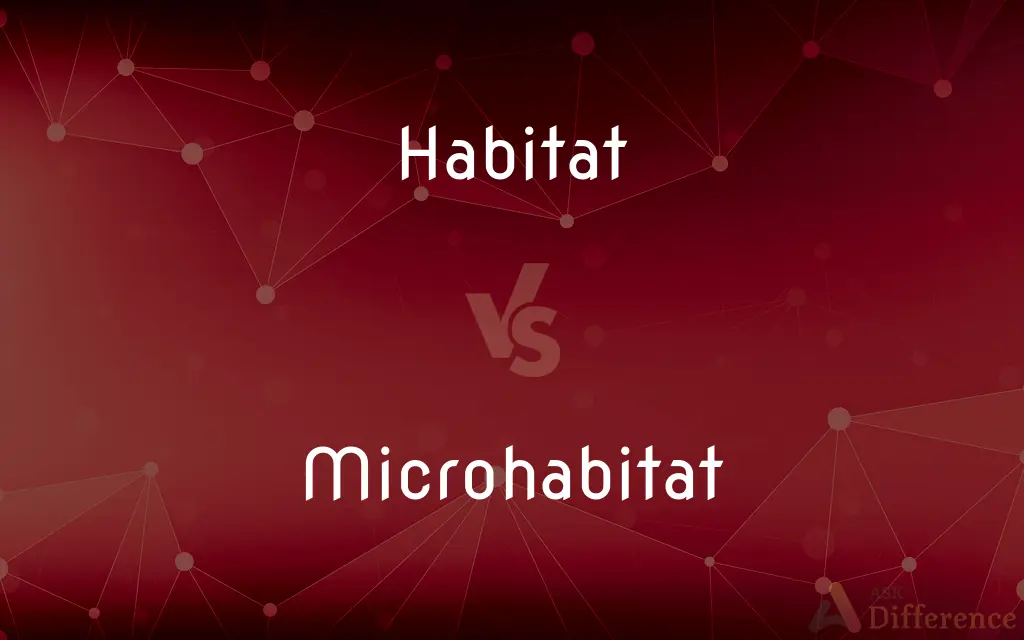Habitat vs. Microhabitat — What's the Difference?
By Fiza Rafique & Maham Liaqat — Updated on April 3, 2024
A habitat encompasses the broader living environment of a species, while a microhabitat represents specific, smaller areas within a habitat where particular conditions allow for the existence of certain organisms.

Difference Between Habitat and Microhabitat
Table of Contents
ADVERTISEMENT
Key Differences
A habitat is a large ecological area where various species live, characterized by its geographical features, climate, vegetation, and the animal species that reside within it. It provides the resources necessary for the survival of species, including food, water, and shelter. Microhabitats, on the other hand, are specific, smaller segments within a habitat that offer unique conditions which may differ significantly from the surrounding area. These conditions are crucial for the survival of particular organisms that have adapted to thrive in these niche environments.
While habitats can be seen as the "big picture" environment encompassing large ecosystems such as forests, deserts, or oceans, microhabitats focus on the details within these ecosystems, such as the underside of a rock, a rotting log, or a small pond. The distinction between habitat and microhabitat highlights the scale at which ecological interactions and living conditions are observed and the specificity of environmental requirements for different organisms.
The concept of a habitat is used to discuss the broader environmental and ecological contexts in which a variety of species can survive and interact. In contrast, microhabitats are often discussed in relation to specific species or groups of organisms that require particular environmental conditions that are not representative of the larger habitat as a whole. For instance, a coral reef is a habitat that includes many microhabitats, such as the crevices where specific fish species find protection or areas with particular light conditions preferred by certain types of algae.
Conservation efforts often consider both habitats and microhabitats to ensure the survival of species. Protecting a habitat may ensure the survival of many species, but attention to microhabitats is crucial for preserving biodiversity, especially for those species with very specific environmental needs. The conservation of microhabitats is often a more delicate task, requiring detailed knowledge of the life cycles and needs of the organisms that inhabit them.
Understanding the relationship between habitat and microhabitats is essential for ecological studies and environmental management. It acknowledges the complexity of ecosystems and the variety of conditions necessary to support different forms of life. While habitats provide a general home for species, microhabitats cater to the unique needs of specific organisms, illustrating the intricacy of nature's balance.
ADVERTISEMENT
Comparison Chart
Scale
Broad area supporting diverse life forms
Specific, localized area within a habitat
Characteristics
Defined by general climate, geography
Defined by very specific conditions
Examples
Forests, deserts, oceans
Under rocks, tree bark, shallow water pools
Focus in Ecology
Overall environment and ecosystem
Niche conditions for particular species
Conservation
General protection of ecosystems
Targeted efforts for specific conditions
Compare with Definitions
Habitat
Defined by geographical and climatic features.
Coral reefs are marine habitats rich in biodiversity.
Microhabitat
Offers unique conditions crucial for certain organisms.
The microhabitat under a rock provides moisture and shelter for insects.
Habitat
A large ecological area that supports diverse species.
The Amazon rainforest is a biodiverse habitat.
Microhabitat
A specific, localized environment within a larger habitat.
Moss growing on the north side of a tree forms a microhabitat.
Habitat
Subject to environmental and conservation concerns.
Conservation efforts aim to protect endangered species' habitats.
Microhabitat
May differ significantly from the broader habitat.
A decaying log in a forest offers a microhabitat for fungi and decomposers.
Habitat
The natural home or environment of an animal, plant, or other organism.
Polar bears' habitat is the Arctic ice.
Microhabitat
Essential for the survival of niche species.
Certain amphibians require specific microhabitats with constant humidity.
Habitat
Supports the basic needs of species.
Wetlands are critical habitats for many bird species.
Microhabitat
Conservation of microhabitats is key for biodiversity.
Protecting microhabitats within a coral reef supports diverse marine life.
Habitat
In ecology, the term habitat summarises the array of resources, physical and biotic factors that are present in an area, such as to support the survival and reproduction of a particular species. A species habitat can be seen as the physical manifestation of its ecological niche.
Microhabitat
A very small, specialized habitat, such as a clump of grass or a space between rocks.
Habitat
The natural environment in which a species or group of species lives
Good coyote habitat.
Managing wildlife habitat.
Microhabitat
A specific habitat, typically extremely small, such as a cave corner or a cardboard box.
Habitat
A particular kind of natural environment
Woodland and prairie habitats.
Habitat
An artificial environment created for an animal to live in
The lion habitat at the zoo.
Habitat
A structure that affords a controlled environment for living in extremely inhospitable locations, such as an underwater research laboratory.
Habitat
The place where a person lives or is most likely to be found
"This park became his habitat—a bench-sitter at 17" (Neal Cassady).
Habitat
Conditions suitable for an organism or population of organisms to live.
This park offers important amphibian habitat and breeding area.
Habitat
A place or type of site where an organism or population naturally occurs.
Habitat
A terrestrial or aquatic area distinguished by geographic, abiotic and biotic features, whether entirely natural or semi-natural.
Habitat
A place in which a person lives.
Habitat
The natural abode, locality or region of an animal or plant.
Habitat
Place where anything is commonly found.
This word has its habitat in Oxfordshire.
Habitat
The type of environment in which an organism or group normally lives or occurs;
A marine habitat
He felt safe on his home grounds
Common Curiosities
What defines a habitat?
A habitat is defined by its geographical features, climate, and the presence of necessary resources for the survival of species.
How does a microhabitat differ from its surrounding habitat?
A microhabitat offers specific conditions, such as humidity, temperature, or light, that may be different from the broader habitat, catering to the unique needs of certain organisms.
Why are microhabitats important for biodiversity?
Microhabitats support the survival of niche species with very specific environmental requirements, contributing to the overall biodiversity within an ecosystem.
How do conservation efforts differ between habitats and microhabitats?
Conservation efforts for habitats focus on protecting large ecosystems, while for microhabitats, they target specific conditions essential for the survival of particular species.
Do all species depend on microhabitats?
Not all species have specific microhabitat needs, but many do rely on them for survival, especially those with very particular environmental requirements.
Can a habitat contain multiple microhabitats?
Yes, a single habitat can contain numerous microhabitats, each supporting different organisms.
How can we identify a microhabitat within a larger habitat?
A microhabitat can be identified by observing smaller areas within a habitat that offer unique physical or environmental conditions distinct from the surrounding area.
What role do microhabitats play in an ecosystem?
Microhabitats play a critical role in an ecosystem by supporting niche species and contributing to the overall complexity and resilience of the ecosystem.
Is the protection of microhabitats as crucial as that of habitats?
Yes, protecting microhabitats is crucial for maintaining biodiversity, especially for species with specialized environmental needs.
Can human activities impact microhabitats?
Yes, human activities such as construction, pollution, and deforestation can destroy or alter microhabitats, posing a threat to the species that rely on them.
Share Your Discovery

Previous Comparison
Depository vs. Repository
Next Comparison
Foetus vs. FetusAuthor Spotlight
Written by
Fiza RafiqueFiza Rafique is a skilled content writer at AskDifference.com, where she meticulously refines and enhances written pieces. Drawing from her vast editorial expertise, Fiza ensures clarity, accuracy, and precision in every article. Passionate about language, she continually seeks to elevate the quality of content for readers worldwide.
Co-written by
Maham Liaqat














































